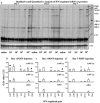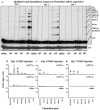Rapid upregulation of interferon-regulated and chemokine mRNAs upon injection of 108 international units, but not lower doses, of adenoviral vectors into the brain
- PMID: 16699048
- PMCID: PMC1472125
- DOI: 10.1128/JVI.00166-06
Rapid upregulation of interferon-regulated and chemokine mRNAs upon injection of 108 international units, but not lower doses, of adenoviral vectors into the brain
Abstract
The innate immune response, characterized by the rapid induction of proinflammatory genes, plays an important role in immune responses to viral vectors utilized in gene therapy. We demonstrate that several innate proinflammatory mRNAs, i.e., those coding for the interferon (IFN)-regulated proteins interferon regulatory factor 1, 2',5'-oligoadenylate synthetase, and double-stranded-RNA-dependent protein kinase as well as those coding for the chemokines RANTES, IFN-gamma-inducible protein 10, and monocyte chemoattractant protein 1, were all increased in a statistically significant manner in response to 1 x 10(8) IU, but not lower doses, of a first-generation adenovirus injected into the naïve brain. This indicates the presence of a threshold dosage of adenovirus needed to elicit an acute innate inflammatory response.
Figures



References
-
- Byrnes, A. P., J. E. Rusby, M. J. Wood, and H. M. Charlton. 1995. Adenovirus gene transfer causes inflammation in the brain. Neuroscience 66:1015-1024. - PubMed
-
- Byrnes, A. P., M. J. Wood, and H. M. Charlton. 1996. Role of T cells in inflammation caused by adenovirus vectors in the brain. Gene Ther. 3:644-651. - PubMed
MeSH terms
Substances
LinkOut - more resources
Full Text Sources
Other Literature Sources
Research Materials

